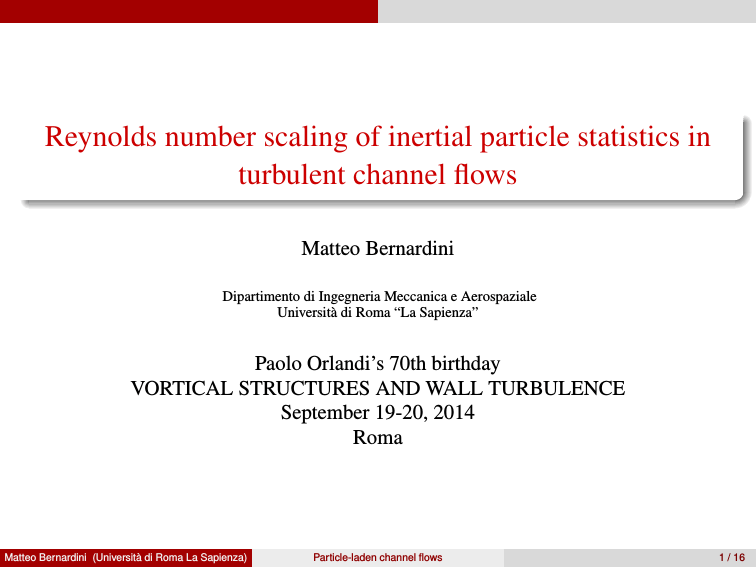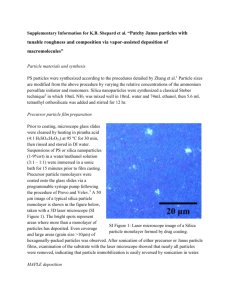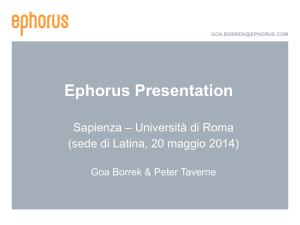Particle-laden turbulent Poiseuille and Couette flows
advertisement

Reynolds number scaling of inertial particle statistics in turbulent channel flows Matteo Bernardini Dipartimento di Ingegneria Meccanica e Aerospaziale Università di Roma “La Sapienza” Paolo Orlandi’s 70th birthday VORTICAL STRUCTURES AND WALL TURBULENCE September 19-20, 2014 Roma Matteo Bernardini (Università di Roma La Sapienza) Particle-laden channel flows 1 / 16 Motivations Turbulent flows laden with solid particles common in nature and technology Transport and sedimentation processes Atmospheric dispersion of pollutants Particles droplets in steam turbines Transport of chemical aerosols Matteo Bernardini (Università di Roma La Sapienza) Particle-laden channel flows 2 / 16 Inertial particles in wall-bounded flows Preferential concentration (particle clustering) Inertial particles cannot follow the instantaneous fluid flow streamlines Low particle concentration found in the cores of strong vortices Turbophoretic drift Strong segregation of particles in the near wall-region Net mass transfer against a gradient in turbulence intensity Matteo Bernardini (Università di Roma La Sapienza) Particle-laden channel flows 3 / 16 Inertial particles in wall-bounded flows Preferential concentration (particle clustering) Inertial particles cannot follow the instantaneous fluid flow streamlines Low particle concentration found in the cores of strong vortices Turbophoretic drift Strong segregation of particles in the near wall-region Net mass transfer against a gradient in turbulence intensity Matteo Bernardini (Università di Roma La Sapienza) Particle-laden channel flows 3 / 16 Turbophoresis Turbophoretic drift Preferential concentration in the spanwise direction Particle transfer driven by the action of strong ejections and sweeps (Marchioli & Soldati, JFM 2002) Only intermediate-size particles affected by turbophoresis Matteo Bernardini (Università di Roma La Sapienza) Particle-laden channel flows 4 / 16 Turbophoresis Turbophoretic drift Preferential concentration in the spanwise direction Particle transfer driven by the action of strong ejections and sweeps (Marchioli & Soldati, JFM 2002) Only intermediate-size particles affected by turbophoresis Matteo Bernardini (Università di Roma La Sapienza) Particle-laden channel flows 4 / 16 Background and objectives Background Experimental difficulties (high particle concentration in the viscous sublayer) Most analysis made using DNS coupled with Lagrangian particle tracking Previous studies limited to low Reynolds numbers (Reτ = 150 − 300) Main goal Understand the effect of the Reynolds number Key open questions: is the turbophoretic drift universal with the Reynolds number? what’s the effect of the Reynolds number on the particle deposition rate? DNS up to Reτ = 1000 ! Matteo Bernardini (Università di Roma La Sapienza) Particle-laden channel flows 5 / 16 Background and objectives Background Experimental difficulties (high particle concentration in the viscous sublayer) Most analysis made using DNS coupled with Lagrangian particle tracking Previous studies limited to low Reynolds numbers (Reτ = 150 − 300) Main goal Understand the effect of the Reynolds number Key open questions: is the turbophoretic drift universal with the Reynolds number? what’s the effect of the Reynolds number on the particle deposition rate? DNS up to Reτ = 1000 ! Matteo Bernardini (Università di Roma La Sapienza) Particle-laden channel flows 5 / 16 Background and objectives Background Experimental difficulties (high particle concentration in the viscous sublayer) Most analysis made using DNS coupled with Lagrangian particle tracking Previous studies limited to low Reynolds numbers (Reτ = 150 − 300) Main goal Understand the effect of the Reynolds number Key open questions: is the turbophoretic drift universal with the Reynolds number? what’s the effect of the Reynolds number on the particle deposition rate? DNS up to Reτ = 1000 ! Matteo Bernardini (Università di Roma La Sapienza) Particle-laden channel flows 5 / 16 Numerical methodology Carrier phase Solution of NS equations for a solenoidal velocity field Second-order FD solver on staggered mesh (provided by Orlandi) Discrete kinetic energy preservation Simulations performed in convecting frame (Bernardini et al. 2013) Doubly-Cartesian MPI splitting (x-z → best choice for load-balance) Matteo Bernardini (Università di Roma La Sapienza) Particle-laden channel flows 6 / 16 Numerical methodology Particle phase Particle equations Diluted dispersion of pointwise, spherical particles → one-way coupling Heavy particles, density ratio ρp /ρf ≈ 2700 (sand in air) Motion of a small rigid sphere described by Maxey and Riley (PoF 83) Forces neglected: added mass, fluid acceleration, Basset history force, gravity dxp = up dt dup kp = (u − up ) dt τp (1) Particle relaxation time τp = ρp dp2 /18µ (measure of inertia) Stokes number St = τp /τf → St = τp u2τ /ν Matteo Bernardini (Università di Roma La Sapienza) Particle-laden channel flows 7 / 16 Physical and computational parameters Flow case P150 P300 P550 P1000 Reτ 145 299 545 995 Nx 384 768 1280 2560 Ny 128 192 256 512 Nz 192 384 640 1280 ∆x+ 7.1 7.3 8.0 7.3 ∆z+ 4.7 4.9 5.3 4.8 Tuτ /h 657 410 326 170 T+ 95265 122590 177670 169150 Table : List of parameters for particle-laden turbulent channel flows. St 1 10 25 100 500 1000 dp+ 0.082 0.25 0.41 0.82 1.83 2.58 dp (µm) 1.0 3.2 5.0 10.0 22.4 31.6 τp (s) 9.55 · 10−6 9.55 · 10−5 2.39 · 10−4 9.55 · 10−4 4.78 · 10−3 9.55 · 10−3 ρp /ρf 2700 2700 2700 2700 2700 2700 Table : Relevant parameters for the inertial particles Matteo Bernardini (Università di Roma La Sapienza) Particle-laden channel flows 8 / 16 Analysis of particle dispersion Shannon entropy How quantify the wall accumulation process? Shannon entropy parameter: single global indicator Entropy parameter estimation Slice the box in M slabs Compute pj = Nj /N, j = 1, . . . , M Entropy: S = − M j=1 pj log pj log M S = 0 → particles into a single slab S = 1 → uniform distribution Matteo Bernardini (Università di Roma La Sapienza) Particle-laden channel flows 9 / 16 Analysis of particle dispersion Shannon entropy How quantify the wall accumulation process? Shannon entropy parameter: single global indicator Entropy parameter estimation Slice the box in M slabs Compute pj = Nj /N, j = 1, . . . , M Entropy: S = − S=0 M j=1 S=1 pj log pj log M S = 0 → particles into a single slab S = 1 → uniform distribution Matteo Bernardini (Università di Roma La Sapienza) Particle-laden channel flows 9 / 16 Particle dispersion (Shannon entropy evolution) P150 P300 1.2 1.2 1 S 0.8 0.6 1 0.8 S St = 1 St = 10 St = 25 St = 100 St = 500 St = 1000 0.6 0.4 0.4 0.2 0.2 0 0 50 100 0 150 0 50 t+ (×10−3 ) 100 150 t+ (×10−3 ) P550 P1000 1.2 1 1 0.8 0.8 0.6 0.6 S S 1.2 0.4 0.4 0.2 0.2 0 0 50 100 + t (×10 −3 150 0 50 100 150 t+ (×10−3 ) ) Matteo Bernardini (Università di Roma La Sapienza) 0 Particle-laden channel flows 10 / 16 Wall-normal concentration profiles 0 10 St = 1 -3 10 -4 10 -5 10 St = 10 10 0 10 1 10 2 10 3 10 -3 10 -4 10 -5 10 0 10 1 y 2 10 3 -3 10 -4 10 -5 10 10 St = 100 10 St = 500 c+ c+ 10 -3 10 -3 10 10 -4 10 -4 10 -5 10 -5 10 -5 2 10 3 y 10 3 St = 1000 10-2 -4 10 2 10-1 -3 + 10 0 10 1 1 y 0 10-2 10 10 + 10-1 10-2 0 0 y 10-1 c+ 10 10 + 0 10 St = 25 10-2 + 10 0 10-1 10-2 c+ c+ 10-2 10 0 10-1 c+ 10 10-1 10 0 10 1 10 2 10 3 + y 10 0 10 1 10 2 10 3 y+ Lines: Reτ = 150; Reτ = 300; Reτ = 550; Reτ = 1000. Matteo Bernardini (Università di Roma La Sapienza) Particle-laden channel flows 11 / 16 Spatial organization Instantaneous distribution of St = 25 particles at Reτ = 1000 Spanwise spacing of the particle streaks at (St = 25) 200 ∆p z+ 150 100 50 0 0 200 400 600 800 1000 1200 Reτ Matteo Bernardini (Università di Roma La Sapienza) Particle-laden channel flows 12 / 16 Deposition rate Deposition coefficient The rate at which particle deposit is fundamental for practical purposes particle mass transfer rate at the wall J = dN/dt/Ad bulk concentration C = N/φ In the case of channel flow kd = −J/C = h dN N dt (2) kd has dimension of velocity kd+ = Matteo Bernardini (Università di Roma La Sapienza) 1 dN h N dt uτ Particle-laden channel flows (3) 13 / 16 Deposition coefficient 10 1 Reτ 100 kd+ 10-1 10 -2 10 -3 10 -4 10 0 10 1 10 2 10 3 St Lines: Reτ = 150; Reτ = 300; Reτ = 550; Reτ = 1000. kd+ = 1 dN h N dt uτ Matteo Bernardini (Università di Roma La Sapienza) dt = dt+ δv uτ Particle-laden channel flows → kd+ 1 dN = Reτ N dt+ (4) 14 / 16 Deposition coefficient 10 1 Reτ 100 kd+ 10-1 10 -2 10 -3 10 -4 10 0 10 1 10 2 10 3 St Lines: Reτ = 150; Reτ = 300; Reτ = 550; Reτ = 1000. kd+ = 1 dN h N dt uτ Matteo Bernardini (Università di Roma La Sapienza) dt = dt+ δv uτ Particle-laden channel flows → kd+ 1 dN = Reτ N dt+ (4) 14 / 16 Deposition coefficient Inner-scaling replacements Deposition rate of segregated particles collapse in inner units 10 1 kd+ /Reτ 100 10-1 10 -2 10 -3 10 -4 10 0 10 1 10 2 10 3 St Lines: Reτ = 150; Reτ = 300; Reτ = 550; Reτ = 1000. Matteo Bernardini (Università di Roma La Sapienza) Particle-laden channel flows 15 / 16 Conclusions DNS of particle-laden turbulent channel flows up to Reτ = 1000 Particle St numbers in the range St = 1 − 1000 Universality of the turbophoretic drift Particle concentration curves collapse in inner-scaling Spanwise spacing of particle streaks constant with Reτ Inner-scaling to collapse the deposition rate of segregated particles Reference M. Bernardini, Reynolds number scaling of inertial particle statistics in turbulent channel flows, JFM-RP 2014, in press Acknowledgments Thanks to P. Orlandi, S. Pirozzoli and F. Picano Matteo Bernardini (Università di Roma La Sapienza) Particle-laden channel flows 16 / 16


